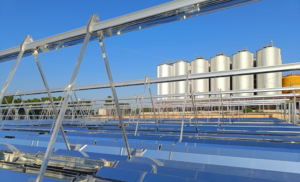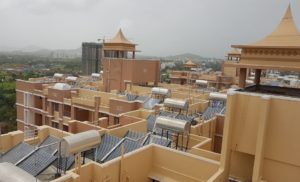

Hungary: New Money for Commercial and Public Solar Thermal Systems
From the end of 2011 on, the Hungarian government had asked the European Commission (EC) to allow the transfer of funds not spent within the Transport Operational Programme, KözOP, to the Environment and Energy Operational Programme, KEOP. The EC finally agreed in September 2012 and the government was able to announce the first tenders a few months later. “The Hungarian wish to rearrange the EU money was due to the huge funding demand for energy projects, which meant KEOP had been running out of resources,” says Katalin Zsóka, Assistant of Béla Glattfelder, a member of the European Parliament who founded Hungary’s solar association in November 2010.
On 21 February 2013, the responsible National Development Agency (NDA) was able to announce some new energy schemes within the Green Economic Development Programme of the Hungarian New Széchenyi Plan (NSzP). Under the title “The most popular energy schemes have already been available in the framework of the New Széchenyi Plan,” the NDA presented five different tenders which support renewable energies, including the installation of solar thermal systems in 2013. Target group in all five cases were projects of enterprises, public institutions or non-governmental organisations:
- “Developing the energy performance of buildings combined with the use of renewable energy sources” is a tender which tries to encourage people to use decentralised renewable energy sources. Its budget is HUF 30 billion (EUR 102.6 million) and the lowest project support amounts to HUF 1 million (EUR 3,420). The maximum amount of money for businesses is HUF 50 million (EUR 170,000) while public institutions can receive up to HUF 500 million (EUR 1.7 million). Applications can be submitted between 5 February 2013 and 31 October 2013.
- “Enhancing the energy performance of the district heating sector with the potential use of renewable energy sources” is a programme which seems to have already started in December 2012, according to the above-mentioned NDA announcement. The call aims to reduce CO2 emissions at the local level by modernising the energy infrastructure of district heating networks. It has a budget of HUF 4 billion (EUR 13.68 million), with a minimum grant of HUF 10 million (EUR 34,200) and a maximum of 1 billion (EUR 3.42 million). Enterprises can apply for the grants between 5 February 2013 and 31 October 2013.
- “Supply of local heating and electricity demand from renewable energy sources” aims to support the use of decentralised green energy systems and includes the installation of solar collectors, solar PV systems and solid biomass boilers. Its funds amount to HUF 7 billion (EUR 23.9 million). Grants range from HUF 1 million (EUR 3,420) to a maximum of HUF 50 million (EUR 170,000). The tender starts on 18 March 2013.
- The fourth call mentioned in the NDA announcement has the title “Supply of local heating and cooling demand with renewable energy sources”. It supports the replacement of energy sources for existing systems with a funding budget of HUF 11.5 billion (EUR 39.33 million), with a minimum grant of HUF 50 million (EUR 170,000) and a maximum one of HUF 1 billion (EUR 3.42 million). Applications will be accepted from 18 March 2013 on.
- “Renewable energy based electricity, heat and electricity cogeneration and biomethane production” has a funding budget of HUF 16.5 billion (EUR 56.43 million) and provides applicants with grants ranging from HUF 50 million (EUR 170,000) to HUF 1 billion (EUR 3.42 million). Applications can be submitted from 18 March 2013 on.
“The subsidies are non-refundable,” explains Pál Varga, Chair of the Solar Thermal Association of Hungarian Building Engineers and adds that companies may get up to 60% of their project costs back. State and self-governing institutions, such as schools, may receive 85% and non-governmental social institutions 100% of their project costs. Varga, however, is sceptical, not only because the implementation of the programme was extremely complex and time-consuming but in general. “While the last year was very satisfactory for the solar thermal market in Hungary due to the residential incentive programme, which allowed the realisation of 4,000 new solar thermal systems, the prospects for 2013 are not very promising,” he says. The subsidy scheme, which was launched at the beginning of October 2011, expired after several extensions on 15 May 2012 with a final count of 5,686 applications.
Varga expects the funds for institutional applicants in the KEOP to be mainly used for energy efficiency measures and other types of renewable energy sources, but not for solar thermal collectors. “While the Hungarian economy is struggling, the construction industry is suffering from depression and there is no support for the retrofit of semi-detached houses or blocks of flats,” Varga regrets.
More information:
Hungarian National Development Agency http://www.nfu.hu/news
New Széchenyi Plan (NSzP) http://ujszechenyiterv.gov.hu
Magyar Szolár Szövetség (Hungarian Solar Association): http://www.maszolar.hu/
Magyar Épületgépészek Napenergia Szövetsége (Solar Thermal Association of Hungarian Building Engineers): http://www.megsz.hu


